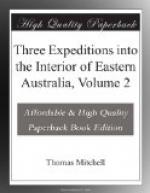As I ascended a grassy hill two miles beyond it I perceived on my left another smaller lake; with no reeds about it, but with grass growing to the water’s edge; and there we also found a curious little plant covered with short imbricated silvery leaves, but not in flower. Behind the lake, or away from the river, was the low scrub of the back country in which I again saw, just coming into flower, the Cassia heteroloba discovered on the 6th instant. On reaching the top of the hill I discovered to the eastward a third lake, much larger than either of the others, and apparently of a different character for its banks were higher, and it contained one or two small islets while the surface of the water was covered with some brown aquatic weed. It was bounded on the east by a ridge which seemed green, smooth, and quite clear of trees. A low neck of firm ground separated the lake first seen from this; and it was also connected with the hill on which I then stood.
NATIVES ON THE LAKE.
In one place, a narrow line of high reeds appearing likely to impede us, Mr. Stapylton rode forward to examine it. As he reached the spot much smoke suddenly arose, evidently from natives whom he had thus accidentally disturbed. He nevertheless pressed forward amongst the reeds, and soon reappeared on the green hill beyond, thus showing us there was no obstruction, and the carts proceeded through. These reeds enveloped a small creek or hollow through which the floods of the river supplied the lake. In one part was a pool of water, and in another the bottom was so soft that the united strength of two teams was necessary to draw out the wheel of a cart which sunk into it. We found there the huts of natives who had fled on Mr. Stapylton’s approach, having left their fishing spears, skin cloaks, shields, etc. They soon appeared on the lake in twenty-four canoes, all making for the little isle in the centre which, being covered with reeds, was probably their stronghold according to their modes of warfare. The aquatic tribes, as I have elsewhere observed, invariably take to the water in times of alarm, and from among the reeds in their little island these people could easily throw their spears at any assailant without being themselves exposed, or even seen. Piper found in their huts some fragments of blue earthenware, nicely attached with gum to threads by which it would appear that the gins wore them in their hair as ornaments.
SCARCITY OF FUEL ON THE BANK OF A DEEP RIVER.
Being desirous to learn the native names of these lakes, and to obtain some information respecting the rivers, I requested Piper and the two Tommies to remain behind for the purpose of obtaining a parley if possible. I should indeed have encamped by this lake had not the environs been entirely destitute of wood. Before us however, although at the distance of some miles, was a line of majestic trees which appeared to mark the course of a river; and I had directed Mr. Stapylton to lead the party through the reeds along an interval which appeared to be chiefly covered with grass, and by which I expected he would arrive at the line of high trees. Meanwhile I was occupied alone to the southward of the lake, surveying it. Near the margin I found a small fragment of highly vesicular lava.




